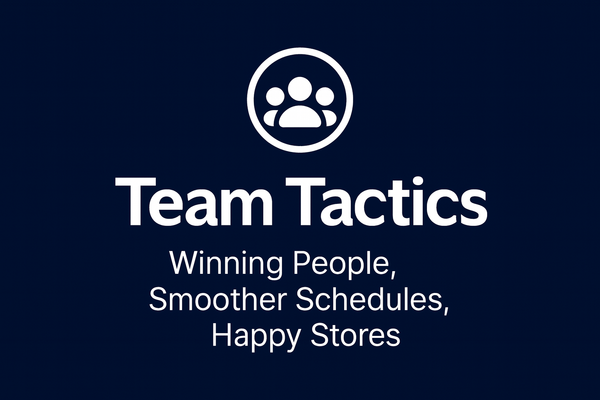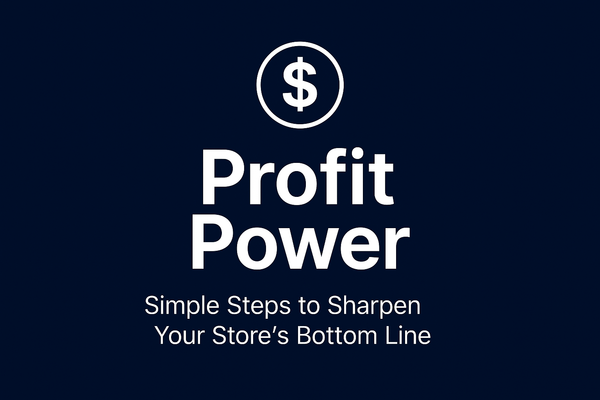The Velocity-Margin Balance: How Smart Operators Choose What to Sell and What to Skip
Smart operators don’t chase volume—they manage velocity and margin together. Learn how to calculate SKU contribution, balance assortment, and boost gross profit per square foot through disciplined subtraction and data-driven focus.

Stores that actively manage the velocity-margin trade-off achieve 15-20% higher gross profit per square foot compared to operators who chase volume alone, according to retail analytics research from Nielsen and IRI. Yet most convenience store operators still add SKUs based on vendor pitches or competitor mimicry rather than strategic analysis of how each item contributes to total profitability.
The problem manifests slowly. Shelves fill with high-volume but low-return products. Sales reports show impressive transaction counts. But when operators calculate profit per square foot, the reality surfaces: stores are working harder to earn less. When shelf space becomes a commodity given freely to any trending SKU, margins erode silently while activity metrics look deceptively healthy.
Understanding the Velocity-Margin Framework
Velocity-margin balance is not about choosing between fast sellers and profitable items. It is about understanding how both metrics work together to determine SKU value. Velocity measures how fast inventory turns, typically expressed as units sold per store per week (UPSW). Margin measures profitability per transaction, expressed as both percentage and absolute dollars.
The critical insight: neither metric alone determines whether a SKU earns its shelf space.
A candy bar turning 50 units weekly at 35% margin ($0.50 profit per unit) generates $25 weekly profit. An energy drink turning 200 units at 18% margin ($0.36 per unit) generates $72 weekly. The energy drink wins on velocity. The candy wins on margin percentage. But the energy drink wins on total contribution, which is what pays rent and labor.
The Four-Quadrant Strategic Framework
Successful category management requires deliberate representation from all four quadrants, not maximizing any single one:
Quadrant 1: High Velocity, High Margin (Stars)
These are the category champions. Prepared food averaging 38% margin with strong daily velocity. Premium coffee programs with 40%+ margins turning multiple times daily. Craft beer selections with 30% margins and reliable weekend velocity. Stars justify premium shelf placement and inventory depth.
Quadrant 2: High Velocity, Low Margin (Traffic Drivers)
Fuel, cigarettes, lottery, and major soda brands fall here. Margins of 15-22% don't justify their space on profitability alone. But these items drive store traffic and enable basket building. The strategic role is attraction, not profit generation. Keep them lean and efficient.
Quadrant 3: Low Velocity, High Margin (Profit Gems)
Specialty items, seasonal offerings, and local products occupy this space. A craft jerky brand might sell 8 units weekly but deliver 45% margin. Premium energy shots move slowly but generate $1.20 profit per unit. These SKUs punch above their weight in absolute dollar contribution despite low velocity.
Quadrant 4: Low Velocity, Low Margin (Elimination Candidates)
This is where profit goes to die. SKUs selling 2-5 units monthly at 18% margin contribute almost nothing while occupying valuable shelf space. Unless they serve a strategic purpose (destination items for specific customer segments), they should be removed quarterly.
The Five Metrics That Matter
Effective velocity-margin analysis requires measuring performance across five dimensions simultaneously:
1. Units Per Store Per Week (UPSW)
This standardizes velocity across categories with different price points. A $1.50 candy bar and $4.00 energy drink can be compared fairly when measured in units moved rather than dollar sales.
2. Gross Profit Per Unit
Percentage margins mislead when products have vastly different retail prices. A 35% margin on a $1.00 item delivers $0.35. A 20% margin on a $5.00 item delivers $1.00. Absolute dollar contribution determines actual value.
3. Gross Profit Per Square Foot
The ultimate performance metric combining velocity and margin. Calculate weekly profit contribution divided by linear shelf feet occupied. Top performers generate $15-25 per square foot weekly. Underperformers deliver $3-5.
4. Inventory Turn Rate
How many times annually inventory cycles through. High-velocity items turning 20-30 times annually require less working capital than slow movers turning 4-6 times. Faster turns reduce both capital requirements and shrinkage risk.
5. Contribution to Total Profit
Each SKU's percentage of overall store gross profit. The top 20% of SKUs typically generate 70-80% of total category profit. These high-contributors deserve proportional shelf space and inventory investment.
Operators who track all five metrics simultaneously can identify high-value SKUs hiding in plain sight and eliminate low-performers masquerading as contributors.
Simplicity Through Strategic Subtraction
Steve Jobs famously said, "Focus by subtraction. Every 'yes' means a hundred 'no's.'" This principle applies perfectly to category management.
Just as Jobs removed every unnecessary button, feature, and product line to focus Apple on what mattered most, convenience store operators must subtract low-return SKUs to create shelf space for high-performers. Saying "yes" to a new energy drink flavor means saying "no" to something currently on the shelf.
The question is not "Does this item sell?" but "Does this item earn its space better than alternatives?"
Simplicity comes from disciplined subtraction, not endless addition.
This mirrors The Office Prodigy's process excellence model: clarity in selection criteria eliminates decision fatigue and creates focus on profit drivers rather than activity metrics. When operators define clear thresholds for SKU approval (minimum UPSW, minimum margin, minimum profit contribution), vendor pitches get evaluated objectively rather than emotionally.
The Compounding Benefits of Velocity-Margin Discipline
Higher Profitability
Filling shelves with proven performers rather than marginal contributors increases gross profit per square foot by 15-20%. A 1,200 square foot sales floor generating $18 per square foot weekly produces $1.12 million annually. At $22 per square foot (through SKU optimization), the same space produces $1.37 million, a $250,000 gain.
Reduced Complexity
Carrying 800 SKUs instead of 1,200 simplifies ordering, reduces shrinkage, and makes staff training easier. Employees learn a focused assortment faster and provide better customer service when they understand what they sell.
Improved Customer Experience
Focused assortments where every item earns its place create cleaner, easier-to-shop environments. Customers find what they want faster when selections are curated rather than cluttered.
Stronger Vendor Negotiations
Data proving which products truly drive results gives operators leverage in distributor conversations. Vendors value shelf space more when they see measurable ROI from placement.
Better Cash Flow
Faster inventory turns and reduced working capital in slow movers free cash for higher-return investments. Moving from 12 inventory turns annually to 18 turns reduces working capital requirements by one-third.
Implementation Strategies for Immediate Impact
Conduct Quarterly SKU Audits
Review the bottom 20% of SKUs by gross profit per square foot. Eliminate those with no strategic value. Exception: destination items that drive specific customer segments (diabetic snacks, baby formula) may warrant retention despite low financial performance.
Apply the 80/20 Rule Rigorously
Identify which 20% of SKUs generate 80% of category profit. Optimize shelf facings and inventory depth for these high-contributors. Top performers may warrant 2-3x more shelf space than average SKUs.
Test High-Margin Replacements
When removing slow, low-margin SKUs, replace with items from the high-margin, moderate-velocity quadrant. Run 90-day trials with clear success criteria. Keep winners, remove failures quickly.
Use Vendor Data Strategically
Request velocity and margin data from distributors, but filter through your store-specific performance lens. What sells well nationally may underperform in your market. Your POS data overrides vendor promises.
Set Clear SKU Approval Criteria
New items must meet minimum thresholds before earning shelf space:
- Projected 10+ UPSW at 25%+ margin, OR
- Projected 50+ UPSW at 15%+ margin, OR
- Fills strategic gap (destination category, demographic need)
Document criteria and apply consistently to eliminate emotional decision making.
Create Category Balance Targets
Define ideal mix across quadrants based on your store positioning:
- Traffic-focused stores: 35% traffic drivers, 35% stars, 20% profit gems, 10% trial
- Destination-focused stores: 25% traffic drivers, 45% stars, 25% profit gems, 5% trial
- Neighborhood stores: 30% traffic drivers, 40% stars, 25% profit gems, 5% trial
Rebalance quarterly to maintain strategic intent.
Building Competitive Advantage Through Focus
Independent operators who master velocity-margin balance gain advantages against chains stuck in one-size-fits-all planograms. National chain assortments optimize for average performance across thousands of locations. Independent operators can optimize for local preferences and superior profitability.
Strategic subtraction creates focused assortments where every SKU justifies its existence through measurable contribution, not habit or inertia. Operators who embrace this discipline don't guess what belongs on their shelves. They measure, compare, and continuously optimize through deliberate subtraction.
The result is not just better margins. It is a simpler, more focused retail operation where employees understand the assortment, customers find what they need faster, and profitability per square foot compounds year after year.
Focus by subtraction. Every "yes" to a high-performer means a hundred "no's" to marginal contributors. That's how great shelves are built.
This article is part of the weekly "Shelf Sense" series from C-Store Thrive.
Found this analysis helpful? Share C-Store Thrive with fellow convenience store owners who want smarter stocking and bigger margins through strategic category decisions that turn every shelf into profit-generating real estate.





